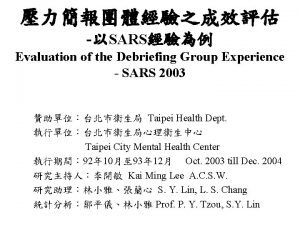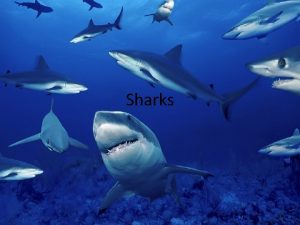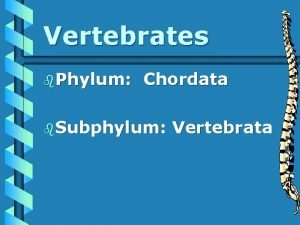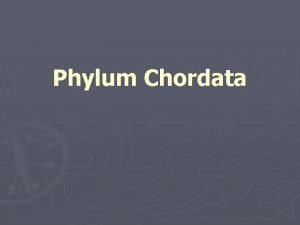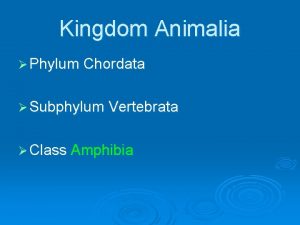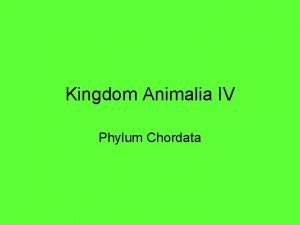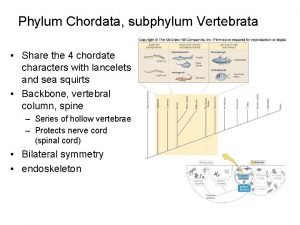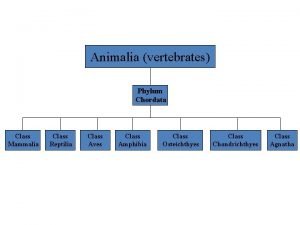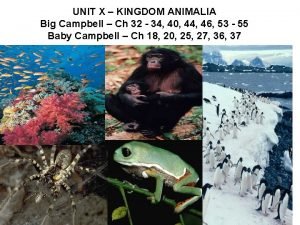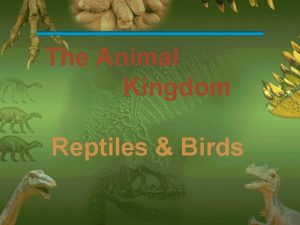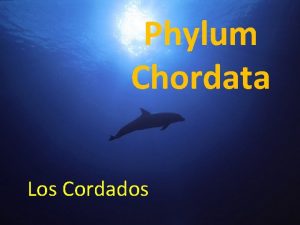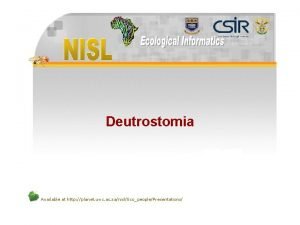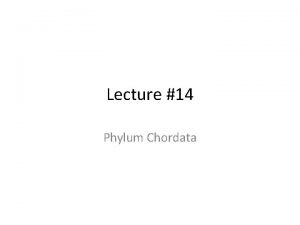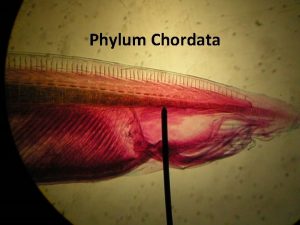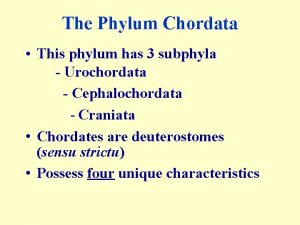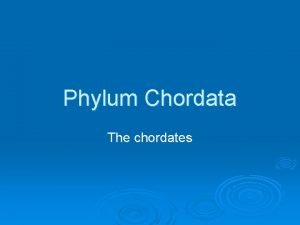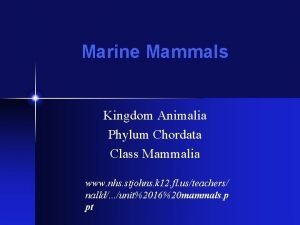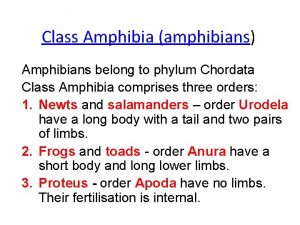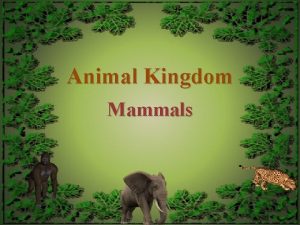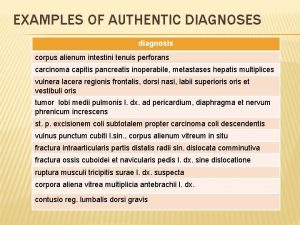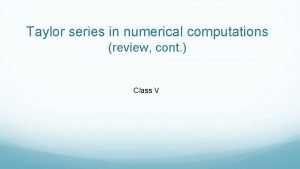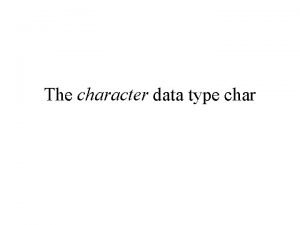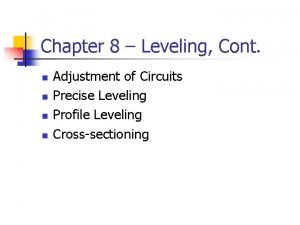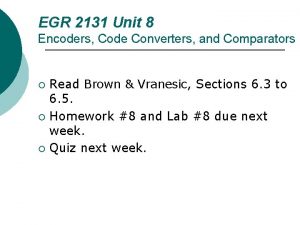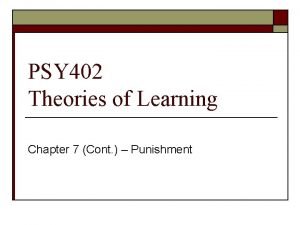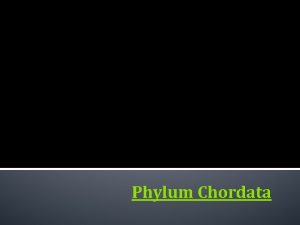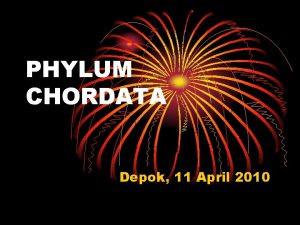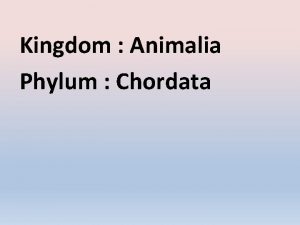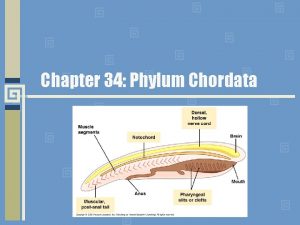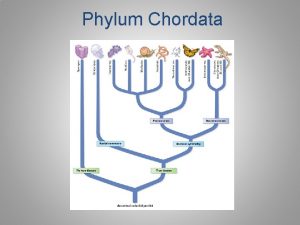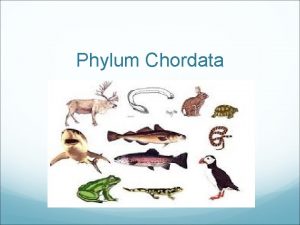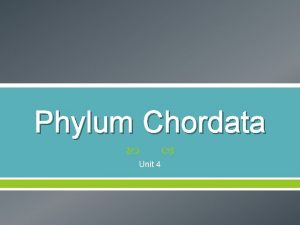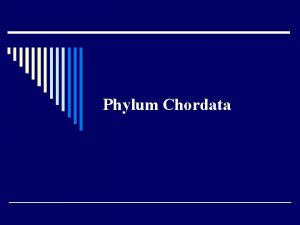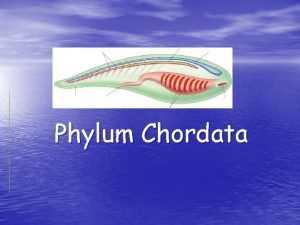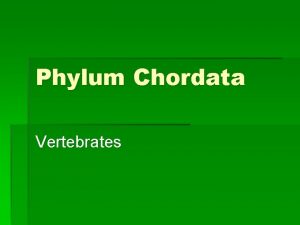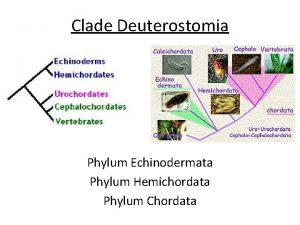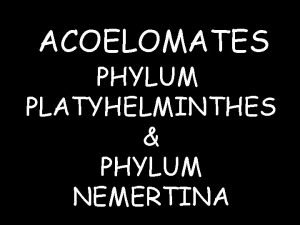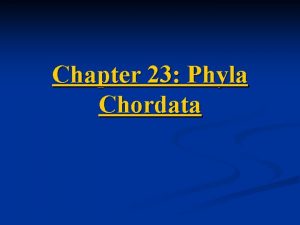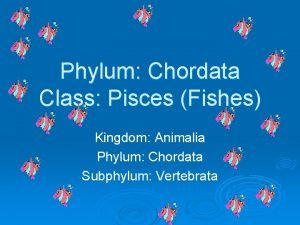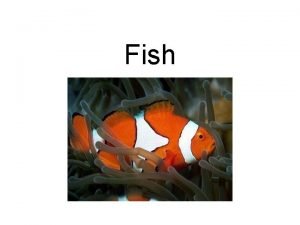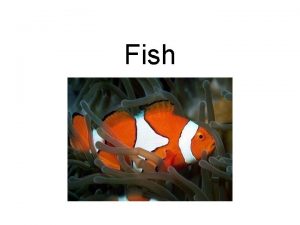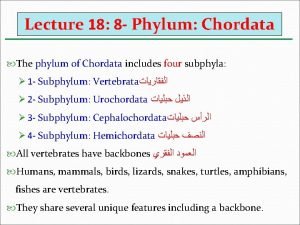V PHYLUM CHORDATA V PHYLUM CHORDATA cont Derived








































- Slides: 40

V. PHYLUM CHORDATA

V. PHYLUM CHORDATA, cont Derived Characters of Chordates ØNotochord – Flexible rod located between digestive tract & nerve cord ØDorsal Hollow Nerve Cord – Eventually develops into brain and spinal cord ØPharyngeal Slits ØPost-anal Tail Recently divided into 4 groups: ØUrochordata ØCephalochordata ØMixini ØVertebrata

V. PHYLUM CHORDATA, cont Invertebrate Chordates Lack a true backbone Suspension feeders Closest vertebrate relatives; appear 50 million years prior to vertebrates Urochordata ØTunicates, sea squirts ØSessile as adults Cephalochordata ØLancelets, amphioxus ØBurrow in sand of ocean floor

V. PHYLUM CHORDATA, cont • Myxini Ø Hagfish Ø Part of group known as craniates meaning they show pronounced cephalization Ø Lack jaws, vertebrae, paired appendages Ø Scavengers Ø Used to considered part of sub-phylum Vertebrata Ø Notochord is present lifelong

VI. PHYLUM CHORDATA – Subphylum Vertebrata Notochord replaced by vertebrae Pronounced cephalization Neural crest Closed circulatory system with chambered heart

VI. PHYLUM CHORDATA - Subphylum Vertebrata Lampreys Used to be grouped in class Agnatha with hagfish Lack jaws, paired appendages Mostly freshwater ectoparasites Cartilaginous skeleton

VI. PHYLUM CHORDATA - Subphylum Vertebrata Class Chondrichthyes Cartilaginous fishes Sharks, skates, rays Well-developed jaws; paired fins Ectotherms Continual water flow over gills Lateral line system (water pressure changes) Internal Fertilization

Class Osteichthyes VI. PHYLUM CHORDATA - Subphylum Vertebrata Ossified endoskeleton Scales Operculum Swim bladder Ectotherms Two groups ØLobe-finned - Fins supported by rod-shaped bones surrounded by a thick layer of muscle; coelocanth; lungfishes ØRay-finned – Most common type; fins supported by long, bony rods arranged in a ray pattern

Class Amphibia CHORDATA - Subphylum Vertebrata VI. PHYLUM First tetrapods, land animals Frogs, toads, salamanders Metamorphosis Ectotherms External fertilization; lack shelled egg Moist skin for gas exchange 2 → 3 chambered heart

Class Reptilia VI. PHYLUM CHORDATA - Subphylum Vertebrata Lizards, snakes, turtles, and crocodilians Internal fertilization Amniotes – Eggs have shells, extraembryonic membranes which aid in gas exchange, transfer of nutrients, protection Ectotherms 3 -chambered heart in most; 4 -chambered heart in crocs Scales with keratin

“Class Aves” VI. studies PHYLUM CHORDATA - Subphylum Vertebrata Fossil show connection between reptiles and birds; birds now included in Class Reptilia Endothermic 4 -chambered Heart Have many other adaptations for flight

Class Mammalia VI. PHYLUM CHORDATA - Subphylum Vertebrata Mammary glands Hair (keratin) Endothermic 4 -chambered heart Large brains (relative to size) Teeth differentiation Diaphragm Divided into three groups ØMonotremes – Egg-layers; platypus, anteaters ØMarsupials – Embryonic development of young completed in pouch; kangaroos, koalas, opossums ØEutherians – Placental mammals; all other mammals

VII. INTRODUCTION TO ANIMAL PHYSIOLOGY • Four Types of Tissue v v

VII. INTRO TO ANIMAL PHYSIOLOGY, cont • Epithelial Tissue § Covers body and lines organs and cavities § Forms glands § May secrete mucus, be ciliated § Held together by tight junctions § Basement membrane o Anchors one side of epithelium to tissues beneath o Extracellular matrix made up of protein, polysaccharides § Classified according to the number of layers of cells and the shape of the cells

VII. INTRO TO ANIMAL PHYSIOLOGY, cont • Connective Tissue § Bind and support other tissues § Consists of cells loosely organized in an extracellular matrix § Matrix is produced and secreted by cells

VII. INTRO TO ANIMAL PHYSIOLOGY, cont • Nerve Tissue § Senses stimuli and transmits signals from 1 part of the animal to another § Two main types of cells v Neuron v Glia

VII. INTRO TO ANIMAL PHYSIOLOGY, cont • Muscle Tissue § Capable of contracting when stimulated by nerve impulses § Fibers § 3 Types of Muscle Tissue Ø Skeletal Ø Cardiac Ø Smooth

VII. INTRO TO ANIMAL PHYSIOLOGY, cont

VIII. PHYSIOLOGICAL REGULATION • Fluid that surrounds cells is known as interstitial fluid • Temperature, water concentration, salt concentration, p. H must be kept relatively constant to maintain homeostasis • Maintained through Ø Negative Feedback Ø Positive Feedback

VIII. PHYSIOLOGICAL REGULATION, cont

VIII. PHYSIOLOGICAL REGULATION Thermoregulation • Ectothermic Ø Determined by environment • Endothermic Ø High metabolic rate generates high body heat • Physical processes Ø Metabolism § Sum of all energy-requiring biochemical reactions § Energy measured in Joules, calories, or kilocalories (Calories) § Metabolic rate may be determined by v Monitoring rate of heat loss v Measuring amount of O 2 consumed or CO 2

VIII. PHYSIOLOGICAL REGULATION Thermoregulation, cont

VIII. PHYSIOLOGICAL REGULATION Thermoregulation, cont • Physical Processes, cont Ø Conduction § Transfer of heat between objects in direct contact Ø Convection § Transfer of heat by movement of air/liquid past a surface Ø Radiation § Transfer of heat between objects not in direct contact Ø Evaporation § Loss of heat in conversion of liquid to gas

VIII. PHYSIOLOGICAL REGULATION Thermoregulation, cont. • Adaptations Ø Torpor - Low activity; decrease in metabolic rate § Hibernation § Estivation Ø Brown Fat Ø Insulation Ø Behavioral Responses

VIII. PHYSIOLOGICAL REGULATION Thermoregulation, cont. • Adaptations, cont Ø Countercurrent Heat Exchangers

VIII. PHYSIOLOGICAL REGULATION Thermoregulation, cont. • Human Thermoregulation

VIII. PHYSIOLOGICAL REGULATION Osmoregulation • Management of the body’s water content and solute composition • Animals may be classified as: v. Osmoconformer: Marine invertebrates. Solute concentration in sea equal to that of organism; therefore, no active adjustment of internal osmolarity (marine animals); isoosmotic to environment v. Osmoregulator: Include marine vertebrates, freshwater animals, land animals. Body fluids have solute concentration different from environment. Must expend energy to regulate water loss or gain.

VIII. PHYSIOLOGICAL REGULATION Osmoregulation, cont • Freshwater fishes Ø Higher solute concentration in fish → fish gains water, loses salt → doesn’t drink water, excretes large amounts of dilute urine • Marine fishes Ø Lower solute concentration in fish → fish loses water, gains salt → drinks large amount of saltwater, pumps

IX. ANIMAL REPRODUCTION

IX. ANIMAL REPRODUCTION Asexual vs Sexual Reproduction

IX. ANIMAL REPRODUCTION • Asexual § Budding § Regeneration Ø Fragmentation Ø Fission

IX. ANIMAL REPRODUCTION Mechanisms of Reproduction • Parthenogenesi s Ø Unfertilized egg development Ø Typically haploid, sterile adults Ø Daphnia, Rotifers, honeybees

IX. ANIMAL REPRODUCTION Mechanisms of Reproduction, cont Hermaphroditism ØBoth male & female reproductive systems ØOccurs in earthworms, other sessile & burrowing organisms

IX. ANIMAL REPRODUCTION Mechanisms of Reproduction, cont Sequential hermaphroditism ØReversal of gender during lifetime ØProtogynous female first ØProtandrous – male first

IX. ANIMAL REPRODUCTION Sexual Reproduction • Pheromes Ø Chemical signals released by organism Ø Influences behavior, physiology of organisms of same species Ø Active in minute amounts • Fertilization Ø External Ø Internal

X. HUMAN REPRODUCTION

X. HUMAN REPRODUCTION Gamete Production

X. HUMAN REPRODUCTION Fertilization Ø Head of sperm contains a vesicle known as the acrosome; contains enzymes that help sperm penetrate egg Ø Acrosomal reaction – hydrolytic enzymes act on egg jelly coat Ø Surface proteins on sperm bind with receptor molecules on egg Ø Sperm cell membrane fuses with egg cell membrane Ø Cell membrane of egg depolarizes, becomes impenetrable to sperm to prevent multiple fertilization (polyspermy) Ø Triggers increase in metabolic activity in fertilized egg (including completion of meiosis II)

X. HUMAN REPRODUCTION Embryonic Development

X. HUMAN REPRODUCTION Fetal Development
 Debriefing report
Debriefing report Cont or cont'd
Cont or cont'd Phylum of shark
Phylum of shark Chordata subphylum vertebrata
Chordata subphylum vertebrata Distinguishing characteristics of chordata
Distinguishing characteristics of chordata Phylum
Phylum Aves kingdom
Aves kingdom What are chordata
What are chordata Chordata subphylum
Chordata subphylum Phylum chordata mammalia
Phylum chordata mammalia Phylum chordata class reptilia
Phylum chordata class reptilia Body covering of animals
Body covering of animals Reptiles order
Reptiles order Phylum cordados
Phylum cordados Characteristics of bony fish
Characteristics of bony fish Amphioxus characteristics
Amphioxus characteristics Animal with notochord
Animal with notochord Subphyla
Subphyla Chordata protostome or deuterostome
Chordata protostome or deuterostome Seal phylum
Seal phylum Phylum chordata class amphibia
Phylum chordata class amphibia Playtpuses
Playtpuses Translate
Translate Pmbo
Pmbo Macro level examples
Macro level examples Cont class
Cont class Adj interrogatif
Adj interrogatif Decathlon nc
Decathlon nc Mobile cont
Mobile cont Contul 301
Contul 301 Character literals
Character literals 4315 cont
4315 cont Cont nn
Cont nn Cont 2131
Cont 2131 Ibc cont
Ibc cont Ejemplos de silabas tonicas y atonas
Ejemplos de silabas tonicas y atonas Api vs system call
Api vs system call Address cont d
Address cont d Operadores relacionales
Operadores relacionales Cont 402
Cont 402 Four cont
Four cont
